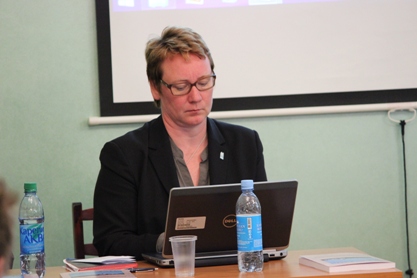Karelia, ¹45 of June 10, 2014
 The Green Belt of Fennoscandia – a chain of protected areas along the national borders between Russia, Finland and Norway – has been once again brought into the focus of public attention. On June 3rd, the workshop "The Future of the Green Belt of Fennoscandia", organized by the Ministry of the Environment, Finland jointly with the Karelian Research Centre, took place at KarRC RAS.
The Green Belt of Fennoscandia – a chain of protected areas along the national borders between Russia, Finland and Norway – has been once again brought into the focus of public attention. On June 3rd, the workshop "The Future of the Green Belt of Fennoscandia", organized by the Ministry of the Environment, Finland jointly with the Karelian Research Centre, took place at KarRC RAS.The outstanding value of this relatively intact boreal belt was pointed out in the mid-1990s, when the territory was nominated for the UNESCO World Heritage List.
– The notion of the "Green Belt of Fennoscandia", brought to life twenty years ago, has been firmly established not only in scientific circles, but also in public policy and national policy discourse, – remarked Karelian Research Centre’s President Alexandr Titov in his opening address to the workshop participants. – A whole number of international documents mentioning the Green Belt of Fennoscandia in the context of priority tasks for international environmental cooperation have been adopted. The new tasks set at the international level today incorporate not only the environmental, but also the socio-economic dimension.
Head of the Environmental Protection Department of the Republic of Karelia Ministry of Nature Use and Environment Tatiana Ilmast, who took part in the workshop, noted that nature conservation projects contribute to economic development of the areas within and around the Green Belt.
– It all began with scientific cooperation, – summed up the workshop leader, Environment Counsellor for the Finnish Ministry of the Environment Kristiina Niikkonen, – but has now grown into a socio-political process. We’re not just speaking nature here, but also social and economic development.
The ‘Future of the Green Belt of Fennoscandia’ is the topic of the fourth workshop in the series organized by the Ministry of the Environment, Finland. The aim for the participants was to determine through collective discussions the development priorities for the Green Belt, and to formulate the cooperation strategy based on these priorities. The task for the workshop in Petrozavodsk was to identify the regionally-specific features that should be taken into account when preparing the strategy. The resultant information shall be used as the background for working out the joint action plan on nature conservation, research, social and economic development of the Green Belt until 2020.
– Time has come, – declared representative of the Finnish Ministry of the Environment Paul Silfverberg, – for us to give a new impetus to development in the Green Belt of Fennoscandia, and promote economic and social development of local communities while at the same time conserving the nature.
Sergey Khokhlov



